Triterpenoid profiling and functional characterization of the initial genes involved in isoprenoid biosynthesis in neem (Azadirachta indica)
- PMID: 26335498
- PMCID: PMC4559364
- DOI: 10.1186/s12870-015-0593-3
Triterpenoid profiling and functional characterization of the initial genes involved in isoprenoid biosynthesis in neem (Azadirachta indica)
Abstract
Background: Neem tree (Azadirachta indica) is one of the richest sources of skeletally diverse triterpenoids and they are well-known for their broad-spectrum pharmacological and insecticidal properties. However, the abundance of Neem triterpenoids varies among the tissues. Here, we delineate quantitative profiling of fifteen major triterpenoids across various tissues including developmental stages of kernel and pericarp, flower, leaf, stem and bark using UPLC-ESI(+)-HRMS based profiling. Transcriptome analysis was used to identify the initial genes involved in isoprenoid biosynthesis. Based on transcriptome analysis, two short-chain prenyltransferases and squalene synthase (AiSQS) were cloned and functionally characterized.
Results: Quantitative profiling revealed differential abundance of both total and individual triterpenoid content across various tissues. RNA from tissues with high triterpenoid content (fruit, flower and leaf) were pooled to generate 79.08 million paired-end reads using Illumina GA ΙΙ platform. 41,140 transcripts were generated by d e novo assembly. Transcriptome annotation led to the identification of the putative genes involved in isoprenoid biosynthesis. Two short-chain prenyltransferases, geranyl diphosphate synthase (AiGDS) and farnesyl diphosphate synthase (AiFDS) and squalene synthase (AiSQS) were cloned and functionally characterized using transcriptome data. RT-PCR studies indicated five-fold and ten-fold higher relative expression level of AiSQS in fruits as compared to leaves and flowers, respectively.
Conclusions: Triterpenoid profiling indicated that there is tissue specific variation in their abundance. The mature seed kernel and initial stages of pericarp were found to contain the highest amount of limonoids. Furthermore, a wide diversity of triterpenoids, especially C-seco triterpenoids were observed in kernel as compared to the other tissues. Pericarp, flower and leaf contained mainly ring-intact triterpenoids. The initial genes such as AiGDS, AiFDS and AiSQS involved in the isoprenoids biosynthesis have been functionally characterized. The expression levels of AiFDS and AiSQS were found to be in correlation with the total triterpenoid content in individual tissues.
Figures
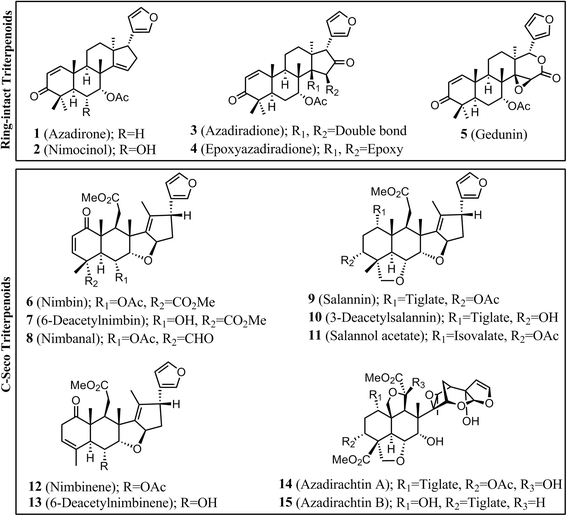
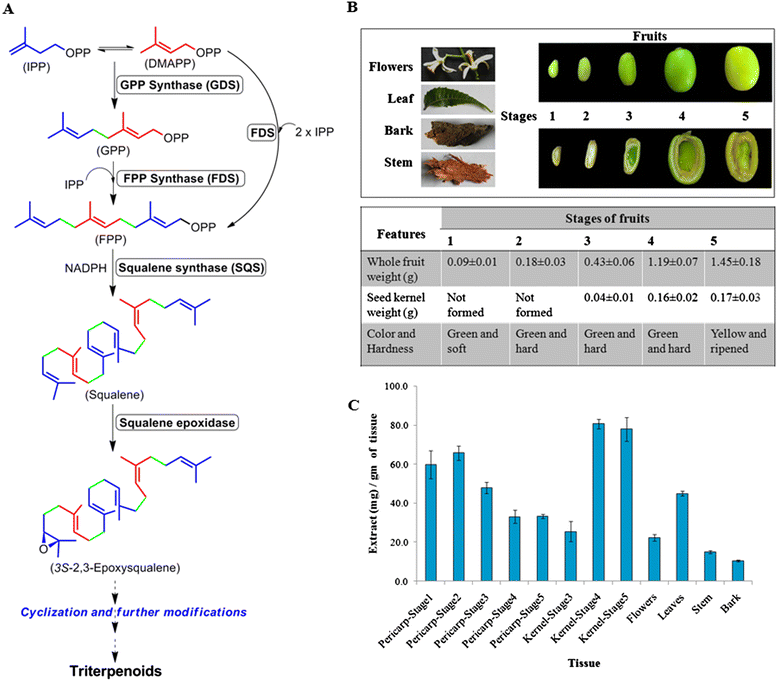
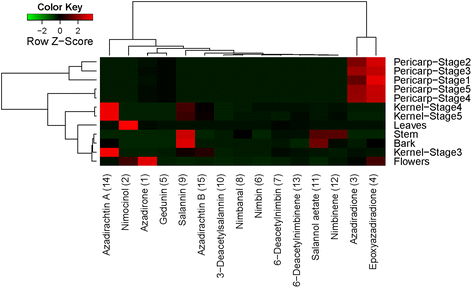
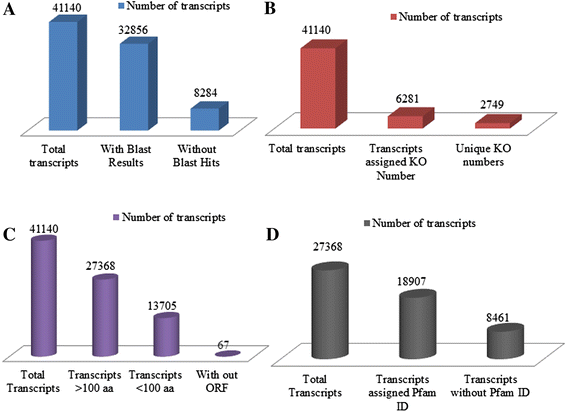
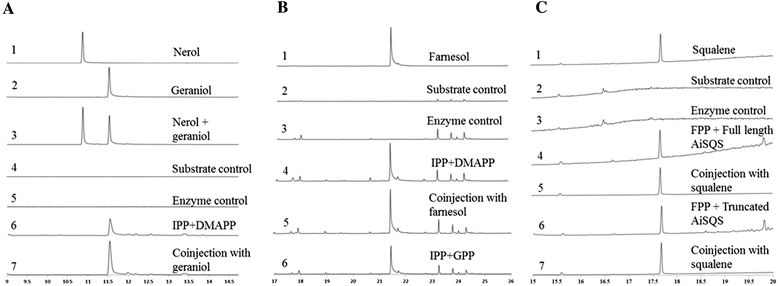
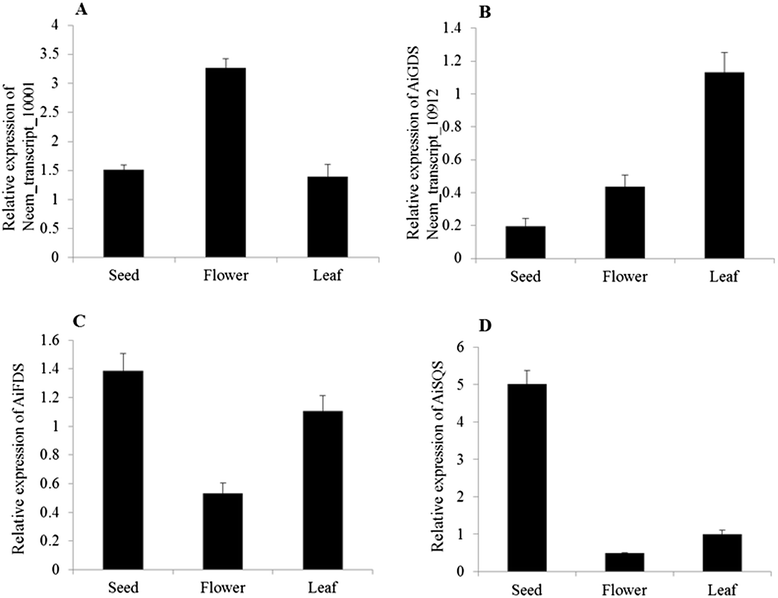
Similar articles
-
Tracing the biosynthetic origin of limonoids and their functional groups through stable isotope labeling and inhibition in neem tree (Azadirachta indica) cell suspension.BMC Plant Biol. 2018 Oct 11;18(1):230. doi: 10.1186/s12870-018-1447-6. BMC Plant Biol. 2018. PMID: 30314459 Free PMC article.
-
Transcriptome and metabolite analyses in Azadirachta indica: identification of genes involved in biosynthesis of bioactive triterpenoids.Sci Rep. 2017 Jul 11;7(1):5043. doi: 10.1038/s41598-017-05291-3. Sci Rep. 2017. PMID: 28698613 Free PMC article.
-
Limonoid biosynthesis 3: Functional characterization of crucial genes involved in neem limonoid biosynthesis.Phytochemistry. 2021 Apr;184:112669. doi: 10.1016/j.phytochem.2021.112669. Epub 2021 Jan 29. Phytochemistry. 2021. PMID: 33524856
-
Biosynthesis and functions of triterpenoids in cereals.J Adv Res. 2025 May;71:155-171. doi: 10.1016/j.jare.2024.05.021. Epub 2024 May 23. J Adv Res. 2025. PMID: 38788922 Free PMC article. Review.
-
Deciphering the key pathway for triterpenoid biosynthesis in Azadirachta indica A. Juss.: a comprehensive review of omics studies in nature's pharmacy.Front Plant Sci. 2023 Nov 7;14:1256091. doi: 10.3389/fpls.2023.1256091. eCollection 2023. Front Plant Sci. 2023. PMID: 38023910 Free PMC article. Review.
Cited by
-
Meliaceae genomes provide insights into wood development and limonoids biosynthesis.Plant Biotechnol J. 2023 Mar;21(3):574-590. doi: 10.1111/pbi.13973. Epub 2022 Dec 26. Plant Biotechnol J. 2023. PMID: 36453987 Free PMC article.
-
Identification of key enzymes responsible for protolimonoid biosynthesis in plants: Opening the door to azadirachtin production.Proc Natl Acad Sci U S A. 2019 Aug 20;116(34):17096-17104. doi: 10.1073/pnas.1906083116. Epub 2019 Aug 1. Proc Natl Acad Sci U S A. 2019. PMID: 31371503 Free PMC article.
-
The MYB transcription factor CiMYB42 regulates limonoids biosynthesis in citrus.BMC Plant Biol. 2020 Jun 3;20(1):254. doi: 10.1186/s12870-020-02475-4. BMC Plant Biol. 2020. PMID: 32493275 Free PMC article.
-
Tracing the biosynthetic origin of limonoids and their functional groups through stable isotope labeling and inhibition in neem tree (Azadirachta indica) cell suspension.BMC Plant Biol. 2018 Oct 11;18(1):230. doi: 10.1186/s12870-018-1447-6. BMC Plant Biol. 2018. PMID: 30314459 Free PMC article.
-
Transcriptome and metabolite analyses in Azadirachta indica: identification of genes involved in biosynthesis of bioactive triterpenoids.Sci Rep. 2017 Jul 11;7(1):5043. doi: 10.1038/s41598-017-05291-3. Sci Rep. 2017. PMID: 28698613 Free PMC article.
References
-
- Champagne DE, Koul O, Isman MB, Scudder GGE, Towers GHN. Biological-activity of limonoids from the rutales. Phytochemistry. 1992;31(2):377–94. doi: 10.1016/0031-9422(92)90003-9. - DOI
-
- Jacobson M. Focus on Phytochemical Insecticides: The Neem Tree. Boca Raton: CRC Press; 1988.
-
- Schmutterer H. The Neem Tree: Source of Unique Natural Products for Integrated Pest Management, Medicine, Industry and Other Purposes. Weinheim, Germany: VCH; 1995.
Publication types
MeSH terms
Substances
Associated data
- Actions
- SRA/SRR2145149
LinkOut - more resources
Full Text Sources
Other Literature Sources

